![]()
![]()
![]()
Use LEFT and RIGHT arrow keys to navigate between flashcards;
Use UP and DOWN arrow keys to flip the card;
H to show hint;
A reads text to speech;
153 Cards in this Set
- Front
- Back
- 3rd side (hint)
|
Potential energy |
energy that is stored in position or configuration. |
|
|
|
kinetic energy |
energy of motion. All moving objects have kinetic energy. |
|
|
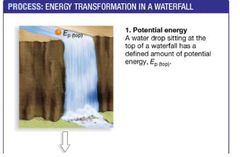
|
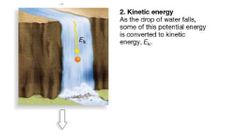
|
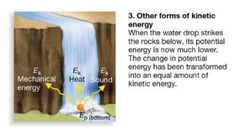
|
|

|

|
|
|
|
The amount of potential energy in a covalent bond reflects the positon of the shared electrons relative to the nuclei of the bonded atoms. |
In general longer weaker bonds with equally shared electrons have high potential energy, and shorter, stronger bonds with unequally shared electrons have low potential energy. |
|
|
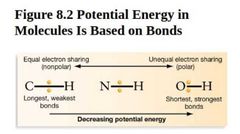
|
Potential Energy stored in the covalent bonds is direclty related to electron postion between atomic nuclei. |
|
|
|
The first law of thermodynamics |
energy is conserved. Energy cannot be created or destroyed, it can obly be transferred and transformed. |
|
|
|
Enthalpy |
The total energy in a molecule. Enthalpy includes the potential energy in the bonds of the molecule, plus the effect of the molecules kinetic energy (movement) on the pressure and volume of tis surroundings. |
|
|
|
Exothermic |
When a reaction releases heat (products have less potential energy than reactants) it is exothermic and Delta H is negative. |
|
|
|
Endothermic |
If heat is taken up during the reaction, generating products that have higher potential energy than the reactants, the reaction is enothermic and Delta H is positve. |
|
|
|
Entropy |
The amount of disorder. Symbolized by S. When the products of a chemical raction become less ordered than the reactant molecuels were, entropy increases and Delta S is positive. |
|
|
|
The second law of thermodynamics |
total entropy always increases in a system that includes the surrouding as wll as the products of the reaction. |
|
|
|
When a Reaction Generates more disorder Entropy increases |
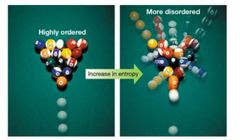
|
|
|
|
Gibbs Free Energy |

To determine whether a chemical reaction is spontaneous, it’s necessary to asses the amountof energy in the reaction available to do work, what chemists call Gibbs free energy(symbolized G). This is accomplished by determining the change in Gibbs free energy (Delta G)for the reaction, which is based on changes in enthalpy and entropy as shown in the equationfor standard free energy change: |
|
|
|
Spontaneous |
Chemical reactions are spontaneous when Delta G is less than zero. Such reactions are said to be exergonic.
Spontaneous chemica reactions run in the direction that lowers the free energy of the system. Exergonic reactions are spontaneous and release energy. |
|
|
|
Non Spontaneous |
Reactions are non spontaneous when Delta G is greater than zero. Such reaction are termed endergonic.
Endergonic reactions are non spontaneous and require an input of energy to proceed. |
|
|
|
Equilibrium |
When Delta G is eqaul to zero. |
|
|
|
Temperature and Concentration Affect Reaction Rates |
For most reactions to proceed, one or more chemical bonds have to break and others have toform. These two events occur together. For this to happen, the substances involved mustcollide at a specific orientation that brings the electrons involved near each other. The number of collisions occurring between the substances in a mixture depends on theirtemperature and concentration.● When the concentration of reactants is high, more collisions will occur andreactions should proceed more quickly.● When their temperature is high, reactants will move faster and collide more Higher concentrations and higher temperatures should therefore speed up chemical reactions.To test this hypothesis, experiments to measure the rate of what's popularly known as the“iodine clock” reaction can be performed under different conditions, as shown in Figure 8.4. PAyspecial attention to the two graphs in the “Results” section: |
|
|
|
iodine clock results |
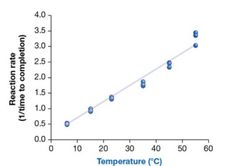
|
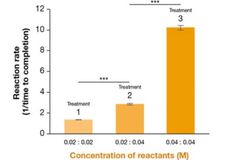
|
|
|
energetic coupling |
coupling between exergonic and energonic reactions. Free energy is used from one reaction to drive another. In cells this process genrally occurs in one of two ways, either through the transfer of electrons or the transfer of a phosphate group. Energetic Couling Allows Endergonic Reactions to proceed using the Free energy from exergonic reactions. |
|
|
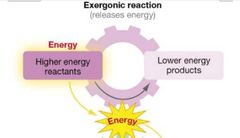
|
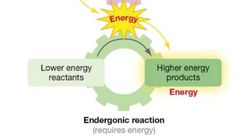
|
|
|
|
Redox Reactions |
Chemical Reactions that involve the loss or gain of one or more electrons |
|
|
|
Redox Reactions Transfer Energy Via Electrons |
Redox Reactions Transfer Energy Via Electrons |
|
|
|
oxidation |
When an atom or molecule loses one ore more electrons it is said to be oxidized.
Oxidation is the spontaneous, exergonic half-reaction; it lowers the potential energyof a reactant |
|
|
|
Reduction |
when an atom or molecule gains one or more electrons Reduction is the nonspontaneous, endergonic half-reaction; it increases thepotential energy of a reactant |
|
|
|
Redox |
Oxidation (electron loss) events are always paired with a reduction (electron gain) event: If oneatom loses an electron, another has to gain it, and Vice versa. Recall, too, that electron positionwithin a covalent bond is related to the potential energy of a bond (see Figure 8.2). |
|
|

|
s |
|
|
|
reduction often “adds H’s |
oxidation often“removes H’s. |
|
|
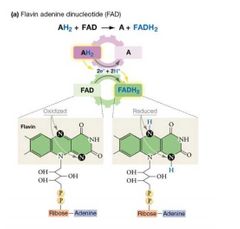
|
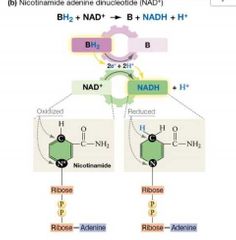
|
|
|
|
ATP Transfers Energy Via Phosphate groups |
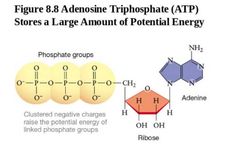
ATP has a great deal of potential energy based on the presence of fournegative charges confined to a small area in its three phosphate groups. In part because thesenegative charges repel each other, the covalent bonds between the phosphate groups are veryweak so the potential energy in the molecule is extraordinarily high ATP’s high potential energy results, in part, from the four negative charges clustered in its threephosphate groups. The negative charges repel each other, raising the potential energy of thebonds between groups. |
|
|
|
ATP Hydrolysis Releases Free energy |
When ATP reacts with water during a hydrolysis reaction, the bond between ATP’s outermostphosphate group and its neighbor is broken, resulting in the formation of ADP and an inorganicphosphate, abbreviated Pi, which has the formula HPO4 2- ( Figure 8.9 on page 182). Thisreaction is highly exergonic. Under standard conditions of temperature and pressure in thelaboratory, a total of 7.3 kilocalories of energy per mole of ATP (or 7.3 kcal/mol) is releasedduring the reaction. A kilocalorie (kcal) of energy raises 1 kilogram (kg) of water 1°C. |
|
|
|
Energy is Released When ATP is Hydrolyzed |

When ATP is hydrolyzed to ADP and inorganic phosphate a large free energy change occurs. ATP hydrolysis is exergonic because the entropy of the product molecules is higher than that ofthe reactants (positive Delta S), and because there is a large drop in enthalpy (negative DeltaH) when ATP is hydrolyzed to form ADP and Pi. The drop in potential energy included in theenthalpy term occurs because the new bonds formed in the products are much stronger thanthose in ATP. The destabilizing effect of the negative charges is also reduced in ADP and Pibecause these products interact with the partial positive Charges on surrounding watermolecules more efficiently than the clustered negative charges on ATP did. |
|
|
|
phosphorylation |
cells don’t lose that 7.3 kcal/mol as heat. Instead, they use it to make thingshappen. Specifically, instead of hydrolyzing ATP and releasing Pi into solution, the phosphategroup is covalently bonded to a target molecule The addition of a phosphate group to a molecule is called phosphorylation. |
|
|
|
phosphorylation can couple exergonic and endergonic reactions |

After the exrgonic transfer of a phosphate group from ATP to B occurs, the free energy of the reactants A and BP is high enough to make the reaction that forms AB exergonic. When a reactant molecule in an endorginic reaction is phosphorylated, the increase in potentail energy in that molecule makes the combined overall reaction exergonic. |
|
|
|
activation energy |
In all reactions, even spontaneous ones, a certain minimum amount of kinetic energy-called theactivation energy- is required to sufficiently strain the chemical bonds in molecules so they canreact to form products. |
|
|
|
Transition State |
intermediate configuration The transition state is the intermediate point between breaking old bonds and forming newones The free energy of the transition state is high because the bonds that existed in theoriginal reactants must be destabilized. Once products form, the free energy drops sharply. |
|
|
|
Changes in Free energy during a chemcial Reaction |
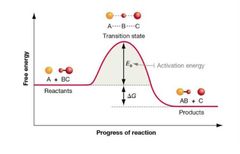
|
|
|
|
Enzymes Help Reaction Clear Two Hurdles |
Before any chemical reaction can take place, two hurdles must be cleared: Reactants need to(1) collide in a precise orientation and (2) have enough kinetic energy to overcome theactivation energy barrier and achieve the transition state. To appreciate how enzymes speed upthis process, let's consider each hurdle in turn. |
|
|
|
Enzymes Bring Substrates Together |
Part of the reason enzymes are such effective catalysts is that they bring substrates together inthe enzyme’s active site (Ch. 3, Section 3.4). Activesite binding helps substrates to collide in aprecise orientation so that particular bonds can break and new bonds can form to generateproducts. To understand how this takes place, let’s look at the structure of enzymes. |
|
|

|
The substrate (reactant) molecules, shown in red and orange, fit into a precise location, calledthe active site, in the green enzyme. In this enzyme and in many others, the binding eventcauses the protein to change shape. |
|
|
|
Induced Fit |
many enzymes undergo a significant change in shape,or conformation, when substrates bind to the active site. You can see this conformationalchange, called an induced fit |
|
|
|
Enzyme Lower Activation Energy |
When substrate molecules enter the active site, they are initially held in place through hydrogenbonding or other weak interactions with amino acid residues in the active site. Once thesubstrate is bound, one or more R-groups in the active site come into play. The degree ofinteraction between the substrate and enzyme increases and reaches a maximum strength, atwhich point bonds in the substrates are destabilized to form the transition state. Thus, byestablishing an environment in the active site that promotes the transition state, enzymesdecrease the activation energy required for the reaction to proceed. Note that thepresence of an enzyme does not affect the overall energy change, Delta G, or change the energy ofthe reactants or the products. In other words, an enzyme will not make an endergonic reactionexergonic, it only lowers the amount of activation energy required for the substrates to achievethe transition state. |
|
|
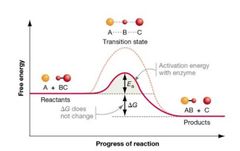
|
The energy profile for the same reaction diagrammed in Figure 8.11, but now with a catalyst(enzyme) present. Even though the energy barrier to the reaction, Ea is much lower, Delta Gdoes not change. |
|
|
|
A three step process to model Enzyme Action |

1. Step 1 Initiation Instead of substrates occasionally colliding in a random fashion, enzymesprecisely orient substrates as they bind at specific locations within the active site.2. Step 2 Transition state facilitation Inside a catalyst’s active site, substrate molecules aremore likely to reach their transition state. In many cases the transition state is stabilized by achange in the enzyme’s shape. Interactions between the substrate and R-groups in theenzyme’s active site lower the activation energy required for the reaction. Thus, the catalyzedreaction proceeds much more rapidly than the uncatalyzed reaction.3. Step 3 Termination The reaction products have less affinity for the active site than thetransition state does. Binding ends, the products are released, and the enzyme returns to itsoriginal conformation. |
|
|
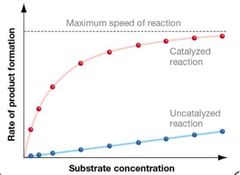
|
When the enzyme concentration is held constant, adding more substrate will markedly increasethe rate of enzyme catalyzed reaction until they reach a maximum |
|
|
|
When substrate concentrations are low, the speed of an enzyme catalyzed reactionincreases in a steep, linear fashion. |
At intermediate substrate concentrations, the increase in speed begins to slow. |
At high substrate concentration, the reaction rate plateaus. |
|
|
Cofactors |
are inorganic ions, such as the metal ions Zn2+ (zinc), Mg2+ (magnesium), andFe2+ (iron), that reversibly interact with enzymes. |
|
|
|
Coenzymes |
are organic molecules that reversibly interact with enzymes, such as the earliermentioned electron carriers NADH or FADH2. |
|
|
|
Prosthetic groups |
are atoms or non-amino acid molecules that are permanently attached toproteins, such as the pigment molecule retinal. Retinal is involved in converting light energy intonerve impulses (Ch. 44, Section 44.3). |
|
|
|
Enzymes Are optimized for Particular Environments |
Temperature affects the folding and movement of an enzyme as well as the kinetic energy of itssubstrates. The concentration of protons in a solution, as measured by pH, also affects enzymestructure and function.
pH affects the charge on acidic and basic groups in residue side chains,and also the active site’s ability to participate in reactions that involve the transfer of protons orelectrons |
|
|
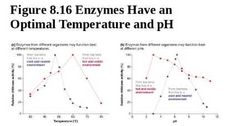
|
The activity of enzymes is sensitive to changes in temperature (a) and pH(b) |
|
|
|
To summarize, the rate of an enzyme-catalyzed reaction depends not only on substrateconcentration and the enzyme’s intrinsic affinity for the substrate, but also on temperature andpH (among other factors). Temperature affects the kinetic energy; both temperature and pHaffect enzyme shape and reactivity. |
To summarize, the rate of an enzyme-catalyzed reaction depends not only on substrateconcentration and the enzyme’s intrinsic affinity for the substrate, but also on temperature andpH (among other factors). Temperature affects the kinetic energy; both temperature and pHaffect enzyme shape and reactivity. |
|
|
|
Most Enzymes Are Regulated |
Controlling when and where enzymes will function is vital to the work of a cell. But whiletemperature and pH affect the activity of enzymes, they are not often used as a means ofregulating enzyme function in a cellular setting. Instead, other molecules, in some cases otherenzymes, regulate most of the cell’s enzymatic activity. These regulatory molecules oftenchange the enzyme’s structure or its ability to bind its substrate in ways that either activate orinactivate the function of the enzyme. |
|
|
|
competitive inhibtion |
The regulatory molecule is similar in size and shape to the enzyme’s natural substrate andinhibits catalysis by binding to the enzyme’s active site. This tactic is called competitiveinhibition because the molecule involved competes with the substrate for access to theenzyme’s active site |
|
|
|
allosteric regulation |
The regulatory molecule binds at a location other than the active site and Changes the shapeof the enzyme. This type of interaction is called allosteric (“different-structure”) regulationbecause the binding event changes the shape of the enzyme in a way that makes the activesite available or unavailable |
|
|
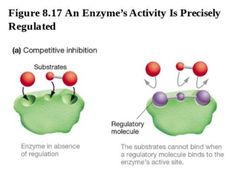
|
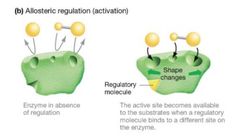
|
|
|
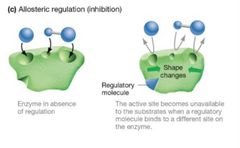
|
s |
|
|
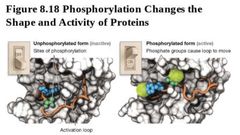
|
When proteins are phosphorylated, they often change shape in a way that alters their activity.The figure shows that structural change that occurs when the activation loop of MAP kinase isphosphorylated. This small change in the proteins structure can have a big effect on itsfunction, like flipping a switch to turn on a light |
|
|
|
Metabolic Pathways |

|
|
|
|
feedback inhibition |
As the concentration of the product molecule becomes abundant, it “feedsback” to stop the reaction sequence |
|
|
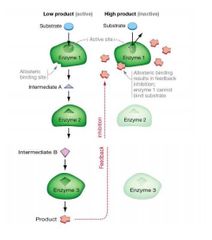
|
feedback inhibition occurs when the product of a metbolic pathway inhibits an enzyme that functions early in the pathway |
|
|
|
catabolism |
Those that break down molecules for sources of energy and carbon building blocks are calledcatabolic pathway |
|
|
|
anabolism |
those that use energy and carbon building blocks to synthesize moleculesare called anabolic pathway |
|
|
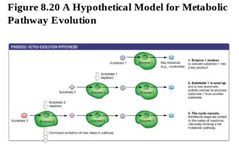
|
s |
|
|
|
Storage Carbohydrates are hydrolyzed |
storage carbohydrates are first hydrolyzed into their glucose monomers. The glucose is then used to produce ATP through one of two general pathways: Cellular respiration or fermentation. |
|
|
|
Cellular Respiration |
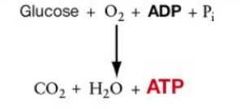
|
|
|
|
Fermentation |

|
|
|
|
Oxidation of Glucose |

A total of about 685 kilocalories of heat is realeased when one mole of glucose is oxidized. In cells the energy released when glucose is oxidised is used to synthesize ATP from ADP and Pi. Cellular Respiration like burning results in the complete oxidation of the carbons in glucose to CO2. |
|
|
|
Fermentation |
does not fully oxidise glucose. Instead small reduced organic molecules are produced as waste. |
|
|
|
Cellular Respiration |
set of four interconnected processes that together convert most of the chemical enrgy in glucose to chemical enrgy in ATP. Each of the four processes consists of a distinctive starting molecule, a series of chemical reactions, and a characteristic set of products. |
|
|
|
4 processes of cellular respiration |
Glycolysis Pyruvate Processing Citric Acid Cycle Electron transport and oxidative phosphorylation |
|
|
|
Glycolysis |
In glycolysis, one six-carbon molecule of glucose is broken into two molecules ofthe three-carbon compound pyruvate. During this process, ATP is produced from ADP and Pi,and nicotinamide adenine dinucleotide (NAD+) is reduced to form NADH. |
|
|
|
Pyruvate Processing |
Each pyruvate produced by glycolysis is processed to release onemolecule of CO2, and the remaining two carbons are used to form the compound acetyl CoA. The oxidation of pyruvate results in more NAD+ being reduced to NADH. |
|
|
|
Citric Acid Cycle |
The two carbons from each acetyl CoA produced by pyruvate processing areoxidized to two molecules of CO2. During this sequence of reactions, more ATP and NADH areproduced, and flavin adenine dinucleotide (FAD) is reduced to form FADH2. |
|
|
|
Electron Transport and Oxidative Phosphorylation |
Electron transport and oxidative phosphorylation Electrons from NADH and FADH2 producedby pyruvate processing and the citric acid cycle move through a series of electron carriers thattogether are called an electron transport chain (ETC). The energy obtained from this chain ofredox reactions is used to create a proton gradient across a membrane; the ensuing flow ofprotons back across the membrane is used to make ATP. Because this mode of ATPproduction links oxidation of NADH and FADH2 with phosphorylation of ADP, it is calledoxidative phosphorylation. |
|
|
|
4 stages of cellular respiration |

The first three stages oxidize glucose and intermediate products to produce NADH and FADH2 which then feed the electron transport chain. |
|
|
|
oxidation of carbons in cellular respiration |

|
|
|
|
catbolic pathways |
Sets of reactions that break down molecules. These reactions often harvest stored chemical energy to produce ATP |
|
|
|
Anabolic Pathways |
sets of reactions that synthesize larger molecules form smaller components. Anobolic reactions often use energy in the form of ATP. |
|
|
|
Fats are used to make acetyl CoA |
In cells, enzymes routinely break down fats to releasethe glycerol and convert the fatty acids into acetyl CoA molecules. Glycerol can be furtherprocessed and enter glycolysis as an intermediate. Acetyl CoA enters the citric acid cycle. |
|
|
|
Proteins are used to make ATP |
Proteins can also be catabolized, meaning that they can be broken down and used to produceATP. Once they are hydrolyzed to their constituent amino acids, enzyme-catalyzed reactionsremove the amino (-NH2) groups. The amino groups are excreted in urine as waste, and theremaining carbon compounds are converted to pyruvate, acetyl CoA, or other intermediates inglycolysis and the citric acid cycle. |
|
|
|
When all three types of molecules are available in the cell to generate ATP, carbohydrates areused up first, then fats, and finally proteins. |
When all three types of molecules are available in the cell to generate ATP, carbohydrates areused up first, then fats, and finally proteins. |
|
|
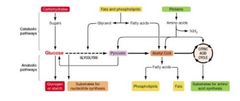
|
a |
|
|
|
glycolysis |
has been observed in nearly every prokaryote and eukaryote. Its logical to infer that the ancestor of all organisms living today made ATP by glycolysis. |
|
|
|
Embden Meyerhof Pamas (EMP) glycolysis |
the most common type of glycolysis |
|
|
|
Entner doudroff pathway |
used in prokaryotes |
|
|
|
glycolysis occurs in the cytosol |
This sequence of 10 cytosolic reactions oxidizes glucose to pyruvate. Each reaction step iscatalyzed by a different enzyme (represented by numbered green ovals) to produce two netATP (4 ATP are produced, but 2 are invested), two molecules of NADH, and two molecules ofpyruvate. In step 4, fructose-1,6-bisphosphate is divided into two products that both proceedthrough steps 6-10. (The amounts for “What goes in” and “What goes out” in 6-10 are thecombined totals for both reactant molecules.) |
4 ATP produced 2 ATP invested NET ATP = 2 2 pyruvate produced |
|
|
Step 1 glycolysis |
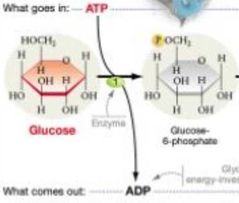
Glycolysis starts by using ATP, not producing it. In the initial step, glucose is phosphorylated to form glucose-S-phosphate. |
|
|
|
Step 2 Glycolysis |
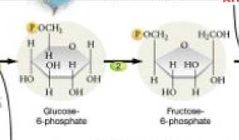
the second reaction rearranges the sugar to form fructose-6-phosphate, |
|
|
|
Step 3 Glycolysis |
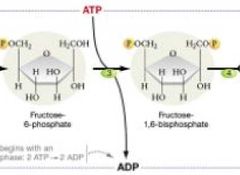
the third reaction adds a second phosphate group, forming thecompound fructose-1,6-bisphosphate |
|
|
|
Step 4 and 5 Glycolysis |
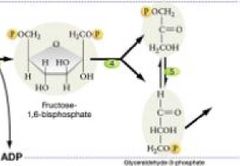
in steps 1-5, two ATP molecules are used up before any ATP is produced. Without ATP, these reactions wouldbe endergonic, so this part of glycolysis is referred to as the energy investment phase. |
|
|
|
Step 6 Glycolysis |
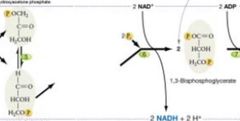
The energy-payoff phase of glycolysis (steps 6-10) consists of exergonic reactions that do not require an input of energy. The first high-energy molecules are produced in the sixthreaction, where two molecules of NAD' are reduced to form two NADH |
|
|
|
Step 7 glycolysis |
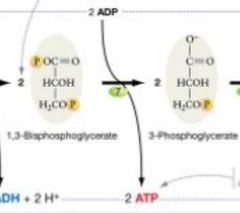
In reactions 7 and 10,enzymes catalyze the transfer of a phosphate group from a phosphorylated substrate to ADP,forming ATP. When ATP is produced in this manner, it is termed substrate levelphosphorylation |
|
|
|
Step 9 glycolysis |
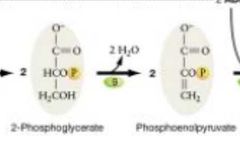
|
|
|
|
Step 10 glycolysis |
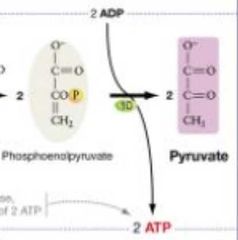
In reaction 10,enzymes catalyze the transfer of a phosphate group from a phosphorylated substrate to ADP,forming ATP. When ATP is produced in this manner, it is termed substrate levelphosphorylation |
|
|
|
glycolysis |
Goes in: 2 ATP, 2 NAD+, 4 ADP
Comes out: 2 ADP, 2 NADH + 2H+, 4 ATP, 2 H2O, 2 pyruvate
For each molecule of glucose processed by glycolysis, the net yield is two molecules ofNADH, two of ATP, and two of pyruvate |
|
|
|
Substrate level Phosphorylation |

Substrate level phosphorylation occurs when an enzyme catalyzes the transfer of a phosphategroup from a phosphorylated substrate to ADP, forming ATP |
|
|
|
phosphofructokinase |
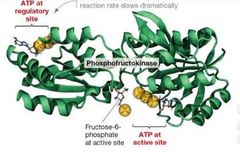
Phosphofructokinase catalyzes reaction 3. (synthesis of fructose-l,6-bisphosphatefrom fructose-6-phosphate.) high levels of ATP inhibit a key glycolytic enzyme called phosphofructokinase phosphofructokinase has two distinct binding sites for ATP. ATP can bind at the enzymes activesite, where it is used to phosphorylate fructose-6-phosphate, or at a regulatory site, where itturns off the enzymes activity Whenconcentrations are low, ATP binds only to the active site, which has a greater affinity for ATPthan does the regulatory site. As ATP concentrations increase, however, it also binds at theregulatory site on phosphofructokinase. When ATP binds at this second location, the enzyme’sconformation changes in a way that dramatically lowers the reaction rate at the active site |
|
|
|
feedback inhibition in glycolysis contributes to cellularhomeostasis. |
Cells that areable to stop glycolytic reactions when ATP is abundant can conserve their stores of glucose fortimes when ATP is scarce |
|
|
|
Pyruvate processing |
the pyruvate produced by glycolysis is transported from the cytosol to mitochondria Pyruvate processing occurs within the mitochondrial matrix. Pyruvate moves from the cytosol across the mitochondrial outer membrane through small poresand is then transported into the matrix through a carrier protein in the inner membrane. Oncepyruvate is inside the matrix, it is processed by an enormous and intricate enzyme complexcalled pyruvate dehydrogenase. |
|
|

|
s |
|
|
|
Pyruvate Dehydrogenase |
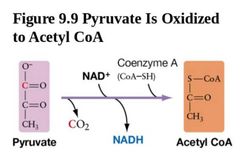
Pyruvate dehydrogenase couples the oxidation of one carbon in pyruvate to the reduction ofNAD+, resulting in the release of a C02 molecule and production of NADH.
The same enzymecomplex then takes the two-carbon acetyl unit (-COCH3) and covalently bonds it to acompound called coenzyme A (CoA),
The product of this final reaction iscalled acetyl CoA (Bgure 9.9). In this and many other reactions, CoA acts as a coenzyme byaccepting and then later transferring an acetyl group to another substrate |
|
|
|
pyruvate dehydrogenase feedback inhibition |
Like the regulated phosphofructokinase reaction in glycolysis, pyruvate processing is a keycommitment step that is not reversible. Feedback inhibition shuts down pyruvatedehydrogenase when the products of pyruvate processing (NADH and acetyl CoA) or glycolysis(ATP) are in abundant supply. But instead of binding to these products and undergoingallosteric regulation, pyruvate dehydrogenase is shut down when it is phosphorylated by otherenzymes. The rate of phosphorylation increases when one or more of the feedback productsare at high concentration. |
|
|
|
The Electron Transport Chain |

Collectively, the molecules responsible for the oxidation of NADH and FADH2 are designated the electron transport Chain (ETC).
Most of the molecules are proteins that contain distinctive cofactors and coenzymeswhere the redox events take place (Ch.8, Section 8.3). The latter include inorganic ironsulfur complexes, organic ring-containing structures called flavins, or organiciron-containing heme groups called cytochromes. Each of these “helper” groups is readily reduced or oxidized. NADH donates an electron to a flavin-containingprotein (FMN) at the top of the chain, while FADH2 donates electrons to an iron and sulfurcontaining protein (Fe*S). Each of these reduced proteins then passes their electrons directly toa Q molecule. After being transferred through each of the remaining components in the chain,the electrons are finally accepted by oxygen. |
|
|
|
Ubiquinone |
The inner membrane of the mitochondrion also contains a pool of nonprotein moleculescalled ubiquinone. Ubiquinone got its name because it is nearly ubiquitous inorganisms and belongs to a family of compounds called quinones. Also calledcoenzyme Q , or simply Q, Ubiquinone is lipid soluble and moves efficiently throughoutthe hydrophobic interior of the inner mitochondrial membrane. |
|
|
|
Redox Potential |
The molecules involved in oxidizing NADH and FADH2 differ in their ability to acceptelectrons in a redox reaction. This ability is referred to as the redox potential of theelectron acceptors. In addition, some of the molecules pick up a proton with eachelectron, forming bonds to uncharged hydrogen atoms, while others obtain onlyelectrons.
Because Q and the ETC proteins differ in redox potential, investigators realized that it should bepossible to arrange their redox reactions into a logical sequence. The idea was that electronswould pass from a molecule with a lower redox potential to one with a higher redox potential. |
|
|
|
Final Electron Acceptor |
The potential energy in shared electrons steps down from the electron carriers NADH andFADH2 through an electron transport chain to a final electron acceptor. In this electron transportchain, oxygen is the final electron acceptor and it forms water as a by-product. The overall free-energy change of 52 kcal/mol (from NADH to oxygen) is broken into small steps. |
|
|
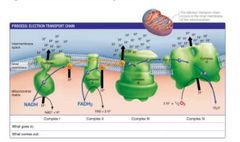
|
Electrons are carried from one complex to another by Q or by cytochrome c; Q also shuttles protons across the membrane(black half-arrows). The orange arrows indicate Q moving back and forth between complexes 1,II, and III. Complexes I and IV use redox reactions to pump protons directly from the mitochondrial matrix to the intermembrane space
Research has shown that when Q accepts electrons from complex I or complex II, it picks up protons from the matrix side of the inner membrane. The reduced form of Q then diffuses through the inner membrane, where its electrons are used to reduce a component of complex III near the intermembrane space. The protons held by Q are then released to the intermembrane space |
|
|
|
chemiosmosis |
the use of a proton gradient to driveenergy requiring processes, like the production of ATP |
|
|
|
proton-motive force |
based on a proton electrochemical gradientacross a membrane. |
|
|
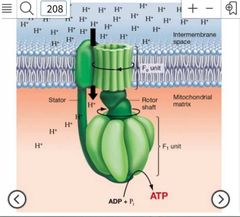
|
ATP synthase is a molecular rotary motor. The F0 unit serves as a rotor whose turning isconveyed to the F1 unit via the shaft. A Flow of protons through the F0 unit causes the rotorand shaft to spin. The motor’s rotation can reach speeds of 350 revolutions per second. To putthis into perspective, if the wheels on a typical car were spinning at this rate, the car would be traveling 1,500 miles per hour.As the shaft spins within the F1 unit, it is thought to change the conformation of the F1 subunitsin a way that catalyzes the phosphorylation of ADP to ATP. This mode of chemosmoticallydriven ATP production was introduced in Section 9.1 as oxidative phosphorylation-a processpowered indirectly by the electron transport chain and executed by ATP synthase. |
|
|
|
It has been determined that the ETC transports enough protons to produce approximately threeATP for each NADH and two for each FADH2, |
a |
|
|
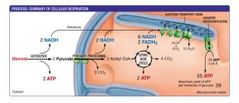
The actual yield of ATP per glucose (29 ATP) is lower than the theoretical calculation (38 ATP)because the proton motive force is used to drive other mitochondrial activities, such as theactive transport of Pi into the mitochondrial matrix |
Recent research shows that about 29 ATP molecules are produced from each molecule ofglucose. Of these, 25 ATP molecules are produced by ATP synthase |
|
|
|
overall equation for cellular respiration |

|
|
|
|
aerobic organisms |
use oxygen as a final electron acceptor |
|
|
|
Variations of Cellular Respiration |
It is important to recognize, though, that cellular respiration can also occur without oxygen.Many thousands of bacterial and archaeal species rely on electron acceptors other thanoxygen, and electron donors other than glucose. For example, nitrate (NO3-) and sulfate (SO42-) are particularly common electron acceptors in species that live in oxygen-poorenvironments(Ch.26, Section 26.3). In addition, many bacteria and archaea use H2, H23, CH4,or other inorganic compounds as electron donors-not glucose. |
|
|
|
anaerobic |
Cells that depend on electron transport chains with electron acceptors other than oxygen aresaid to use anaerobic (“no air”) respiration. Even though the starting and ending points ofcellular respiration differ, aerobic and anaerobic respiring cells still use an ETC to create aproton-motive force that drives the synthesis of ATP. In bacteria and archaea, the ETC andATP synthase are located in the plasma membrane. |
|
|
|
Aerobic Respiration Is Most Efficient |
Even though an array of compounds can serve as the final electron acceptor in cellularrespiration, oxygen provides the greatest energy yield. Because oxygen is so highlyelectronegative, the potential energy in bonds between an oxygen atom and a non-oxygenicatom, such as hydrogen, is low. As a result, there is a large difference between the potentialenergy of reduced electron donors, like NADH, and reduced forms of oxygen, like water (seeFigure 9.14). This large differential in potential energy means that the electron transport chaincan generate a large proton-motive force. Cells that do not use oxygen as an electron acceptor cannot generate such a large potentialenergy difference. As a result, they make less ATP per electron donor, such as glucose, thancells that use aerobic respiration. |
|
|
|
absence of of FEA |
When there is noterminal acceptor, the electrons in each of the complexes of the electron transport chain haveno place to go, and the electron transport chain stops. For example, without an oxidizedcomplex I, NADH remains reduced. The concentration of NAD’ drops rapidly as cells continueto convert NAD+ to NADH. |
|
|
|
fermentation |
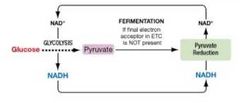
a metabolic pathway that includes glycolysis and an additional set of reactionsthat oxidize stockpiles of NADH to regenerate NAD+. In respiring cells, fermentation serves asan emergency backup so glycolysis can continue to produce ATP even when the ETC andoxidative phosphorylation is shut down if no electron acceptor is available to keep the ETCrunning, then fermentation can regenerate NAD+ by reducing pyruvate, or a product ofpyruvate, with the NADH produced in glycolysis. When oxygen runs out,the electron transport chains shut down and NADH cannot donate its electron there |
|
|
|
lactic acid fermentation |
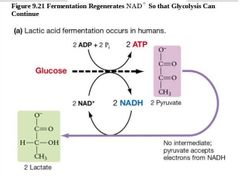
When fermentation takes place in your cells, the pyruvate produced by glycolysis then begins to accept electrons from NADH.
This pathway regenerates NAD+ by reducing pyruvate to form lactate a deprotonated form of lactic acid. When your muscles are deprived of oxygen, your body reacts by making you breathe faster andincreasing your heart rate. By getting more oxygen to your muscle cells, the electron transportchain is revived. The lactic acid produced by fermentation can be converted back to pyruvateand used as a source of energy to continue cellular respiration when oxygen is present.In many cases, however, the cell cannot use the molecule that is formed when pyruvate (oranother electron acceptor) accepts electrons from NADH. This by-product may even be toxicand excreted from the cell as waste even though it has not been fully oxidized. |
|
|
|
Alcohol Fermentation |
occurs in the eukaryote Sacchammycescerevisiae, strains of which are used to make baker’s and brewer ’s yeast. When yeast cellsgrow in bread dough or a bottle of grape juice, they quickly use up the available oxygen.Instead of using NADH to reduce pyruvate, yeast first convert pyruvate to the two-carboncompound acetaldehyde. This reaction gives off carbon dioxide, which causes bread to rise andproduces the bubbles in champagne and beer.Acetaldehyde then accepts electrons from NADH, forming the NAD+ required to keep glycolysisgoing. The addition of electrons to acetaldehyde forms ethanol as a waste product. |
|
|
|
obligate anaerobes |
Bacteria and archaea that rely exclusively on fermentation |
|
|
|
Fermentation as an Alternative to Cellular Respiration |
Even though fermentation is a widespread type of metabolism, it is extremely inefficientcompared with cellular respiration. Fermentation produces just 2 molecules of ATP permolecule of glucose metabolized, while aerobic cellular respiration produces about 29-almost15 times more ATP per glucose molecule than fermentation. The reason for the disparity is thatthe reactions that follow glycolysis in fermentation are not used to generate ATP. |
|
|
|
facultative anaerobes. |
Organisms that can switch between fermentation and aerobic cellular |
|
|
|
Step 1 Citric Acid Cycle |
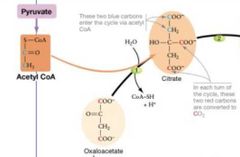
|
|
|
|
Step 2 |
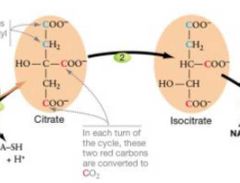
|
|
|
|
Step 3 |
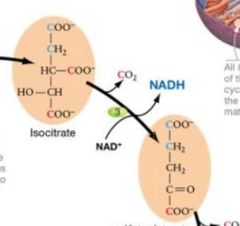
|
|
|
|
Step 4 |
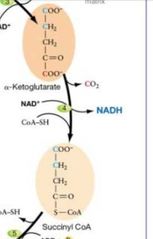
|
|
|
|
Step 5 |
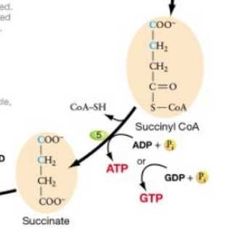
|
|
|
|
Step 6 |

|
|
|
|
Step 7 |
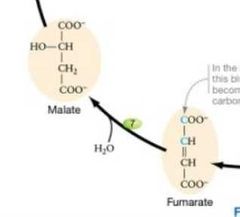
|
|
|
|
Step 8 |
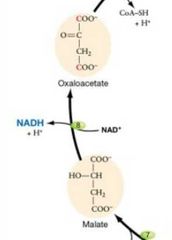
|
|
|
|
The citric acid cycle |
Acetyl CoA(from pyruvate) goes into the citric acid cycle, and carbon dioxide, NADH, FADH2,and ATP or GTP come out. ATP or GTP is produced by substrate-level phosphorylation.
In each turn of the cycle, the energy harvested by oxidizing the acetyl group (-COCH3) fromacetyl CoA(product of the pyruvate processing stage) generates three molecules of NADH, oneof FADH2, and one of ATP or guanosine triphosphate (GTP)
In prokaryotes (bacteria and archaea), the enzymes responsible for the citric acid cycle arelocated in the cytosol. In eukaryotes, these enzymes are located in the mitochondrial matrix.Because glycolysis produces two molecules of pyruvate, each being converted into an acetylCoA, the cycle turns twice for each molecule of glucose processed in cellular respiration |
|
|
|
How is the Citric Acid Cycle Regulated |
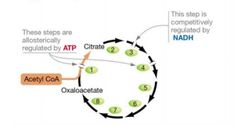
The citric acid cycle can be turned off at multiple points via feedback inhibition. Reaction ratesare high when ATP and NADH are scarce; the rates are low when ATP or NADH is abundant. In step 1, the enzyme that combines acetyl CoAand oxaloacetate to form citrate is shut down when ATP binds at an allosteric regulatory site. Instep 3, NADH interferes with the reaction by binding to the enzyme’s active site. This is anexample of competitive inhibition In Step 4 ATP again functions as an allosteric regulator The citric acid cycle slows down when ATP and NADH are plentiful. ATP acts as an allostericregulator, while NADH acts as a competitive inhibitor. |
|
|
|
Summary of Citric Acid Cycle |
To summarize, each round of the citric acid cycle starts with a two-carbon acetyl molecule in the form of acetyl CoA and ends with the release of two C02. The completion of this cyclemarks the point when all of the carbons from glucose have been fully oxidized to CO2. In addition to producing C02, the free energy obtained from these reactions is used to produce three NADH, one FADH2, and one ATP for each acetyl oxidized. |
|
|
|
Glucose Oxidation |

for each molecule of glucose that is fully oxidized to carbon dioxide (2CO2 molecules during pyruvate processing, 4 during the citric acid cycle), the cell also produces 10 molecules of NADH, 2 of FADH2, and 4 of ATP. The ATP molecules are produced by substrate-levelphosphorylation during glycolysis and the citric acid cycle, and can be used to drive endergonic reactions. The CO2 molecules are a gas that is disposed of as you exhale. |
|
|
|
In eukaryotes, glycolysis occurs in the cytosol; pyruvate oxidation and the citric: acid cycle take place in the mitochondrial matrix. |
s |
|
|
|
Overall Reaction for glucose oxidation |

|
|
|
|
Free energy Change as Glucose is Oxidized |
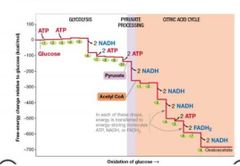
If you read the vertical axis of this graph carefully, it should convince you that the change in freeenergy from the oxidation of glucose is about 685 kcal/mol. Some of this energy is harnessed inthe form of ATP, and some in NADH, and FADH2. The numbered green ovals identify thereaction steps in glycolysis and the citric acid cycle |
|
|
|
Glucose Oxidation |
In glycolysis, pyruvate processing, and the citric acid cycle, redox reactions transfer electrons to NAD+ and FAD to form NADH and FADH2. |
|
|

|
In the above reaction, another set of redox reactions transfers electrons from NADH and FADH2 to oxygen, oxidizing NADH and FADH2 back to NAD+ and FAD and reducing O2 to form water. |
|
|
|
Oxidation of NADH and FADH2 |
By isolating different parts of mitochondria,researchers determined that NADH is oxidized when combined with the inner membrane of themitochondria, including the cristae. In prokaryotes, which lack mitochondria, the oxidation ofNADH requires the plasma membrane. It was hypothesized that these membranes contain thecomponents responsible for oxidizing NADH and FADH2. |
|
|
|
NADH --> NAD+ |
-52.5 kcal/mol |
|
|
|
FADH2 --> FAD |
-35.9 kcal/mol |
|
|
|
ADP --> ATP |
-30.5 kj/mol
7.3 kcal/mol |
|
|
|
kcal |
raises 1 kg of water 1 degree celcius |
|
|
|
oxidation of glucose |
685 kcal 2866 kj |
|
|
|
glycolysis totals |
2 net ATP ( 4 produced 2 invested)
2 NADH
2 pyruvate
2H+
2 H2O
|
|
|
|
pyruvate processing |
occurs in the mitchondrial matrix |
|
|
|
ETC |
produces approximately 3 ATP for each NADH and two ATP for each FADH2 |
|
|
|
citric acid cycle totals |
3 NADH
1 FADH2
1 ATP 2 CO2
cycles twice for each glucose |
|
|
|
citric acid cycle |
occurs in the cytosol (prokaryotes) occurs in the mitchondrial matrix ( eukaryotes) |
|

